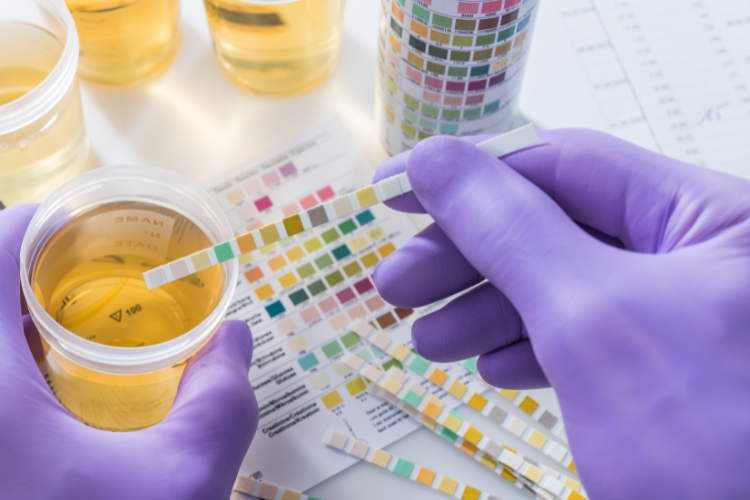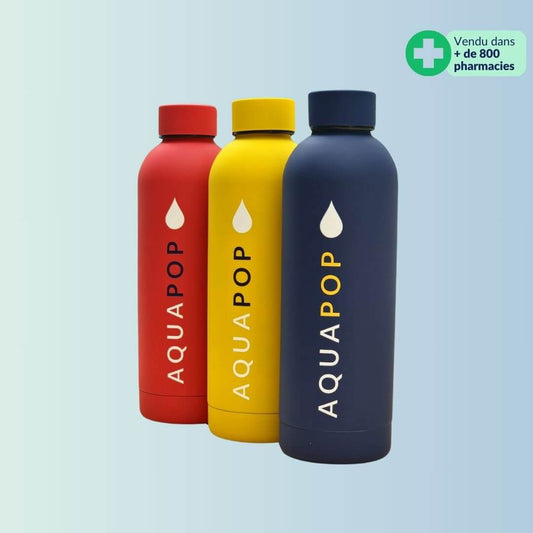The Hédonist Labs team
It may not be glamorous, but we can learn a lot about our hydration status by observing... the color of our urine! And what's that?
Have you ever observed the color of your urine and noticed that it can vary from day to day?
In our ongoing quest to look after our health, it's easy to overlook a fundamental aspect of our well-being: hydration.
The state of our urine may seem a trivial indicator at first glance, but it can actually provide crucial information about our hydration levels and, by extension, our overall health.
Hydration is much more than simply drinking water. It's a vital process by which our body maintains an adequate water balance to ensure the proper functioning of its various systems and organs.
Monitoring your hydration status is crucial to maintaining optimal health. Insufficient hydration can lead to dehydration, characterized by reduced physical performance, cognitive impairment, headaches and even serious medical complications. Conversely, excessive hydration can also present health risks, such as electrolyte dilution and hyponatremia.
That's where urine color comes in. By carefully observing the hue of our urine, we can gain valuable clues about our state of hydration, and adjust our fluid intake accordingly.
Factors influencing urine color
Urine color can be influenced by a number of factors, including waste concentration, the presence of pigments and various external substances. The normal hue of urine generally ranges from straw-yellow to dark yellow, but it can be altered by a number of factors.
Certain foods, such as beet, carrots and asparagus, as well as certain medications, such as B vitamins and medicines for urinary tract infections, can give urine different hues. In addition, dehydration can concentrate waste in the urine, giving it a darker color, while adequate hydration can dilute the urine, making it lighter.
Understanding these factors is essential to correctly interpreting urine color and accurately assessing our hydration status.
The significance of different urine colors
Observing the color of urine can provide valuable clues to our hydration status and overall body health. Here's an analysis of the different shades of urine and what they can reveal:
- Light to pale yellow urine Clear to pale yellow urine is generally a sign of adequate hydration. It indicates that the body is well hydrated and that waste products are sufficiently diluted in the urine.
- Bright yellow to dark yellow: Bright yellow to dark yellow urine can signal a higher concentration of waste in the urine. This may be due to mild dehydration, where the body tries to conserve water by concentrating waste. In some cases, it can also be caused by the consumption of certain foods or medications.
- Orange to dark brown urine Orange to dark-brown urine may indicate severe dehydration or a very high concentration of waste products in the urine. It can also be the result of the presence of certain substances, such as bile pigments or medications.
- Pink to reddish urinePink to reddish urine can be the result of the presence of blood in the urine, which can indicate various health problems, such as urinary tract infections, kidney stones, or prostate disorders in men. In some cases, the consumption of certain foods, such as beet, can also give urine a reddish hue without the presence of blood.
As far as shades of yellow are concerned, the darker the urine, the more this may indicate a higher concentration of waste products and possible dehydration. On the contrary, lighter or pale yellow urine is often associated with adequate hydration.
- It's important to note that these observations about urine color are general indicators, and that other symptoms or factors may also be taken into account to assess a person's overall state of health. If you have any concerns about urine color or hydration status, it is always advisable to consult a healthcare professional.
How to monitor our hydration

Several methods can be used to assess our hydration status, each with its own advantages and limitations:
- Observation of urine color As discussed above, urine color can provide an indication of hydration status. This method is simple and inexpensive, but can be influenced by other factors such as diet or medication.
- Measuring urinary frequency Increased urinary frequency may indicate adequate hydration, as the body regularly eliminates waste products. However, this method can be less reliable, as urinary frequency can be affected by other factors such as caffeine or alcohol consumption.
- Weighing before and after exercise Weighing before and after exercise: For athletes and people involved in strenuous physical activity, weighing before and after exercise can help estimate fluid loss through perspiration. However, this method may not be practical for everyday use.
- Measuring urine concentration Measuring urine concentration using a refractometer or test strips can provide a quantitative assessment of hydration. However, this method requires specific equipment and may be less practical for everyday use.
How to maintain optimal hydration
- Drink enough water: It's recommended to drink around 8 glasses of water a day, but individual needs may vary depending on age, weight, activity level and environmental conditions.
- Establish a water-drinking routine: Try to drink small amounts of water throughout the day rather than consuming large quantities at a time. Keeping a water bottle handy can remind you to stay hydrated.
- Eat water-rich foods: Fresh fruits and vegetables, such as cucumbers, watermelon, lettuce and oranges, are not only rich in nutrients, but also contain a large amount of water, which can contribute to your daily water intake.
- Avoid dehydrating drinks: Limit your intake of drinks containing caffeine, alcohol or lots of sugar, as they can have a diuretic effect and increase the risk of dehydration.
- Watch for signs of dehydrationBe aware of signs such as dry mouth, thirst, fatigue, headaches and decreased urinary frequency, and act accordingly by increasing your water intake.
In short, by carefully monitoring the color of our urine and taking appropriate measures, such as drinking enough water and adjusting our intake as needed, we can maintain optimal hydration and support the proper functioning of our body.
Ultimately, health starts with small daily actions, and monitoring urine color can be a simple but effective way to take care of yourself.





